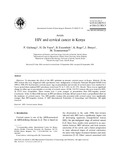| dc.contributor.author | Gichangi, P | |
| dc.contributor.author | De Vuyst, H | |
| dc.contributor.author | Estambale, Benson | |
| dc.contributor.author | Rogo Khama O. | |
| dc.contributor.author | Bwayo, JJ | |
| dc.contributor.author | Temmerman, M | |
| dc.date.accessioned | 2013-06-07T05:35:00Z | |
| dc.date.available | 2013-06-07T05:35:00Z | |
| dc.date.issued | 2002 | |
| dc.identifier.citation | Int J Gynaecol Obstet. 2002 Jan;76(1):55-63. | en |
| dc.identifier.uri | http://www.ncbi.nlm.nih.gov/pubmed/11818095 | |
| dc.identifier.uri | http://erepository.uonbi.ac.ke:8080/xmlui/handle/123456789/29611 | |
| dc.description.abstract | OBJECTIVES:
To determine the effect of the HIV epidemic on invasive cervical cancer in Kenya.
METHODS:
Of the 3902 women who were diagnosed with reproductive tract malignancies at Kenyatta National Hospital (KNH) from 1989 to 1998, 85% had invasive cervical cancer. Age at presentation and severity of cervical cancer were studied for a 9-year period when national HIV prevalence went from 5% to 5-10%, to 10-15%.
RESULTS:
There was no significant change in either age at presentation or severity of cervical cancer. Of the 118 (5%) women who were tested for HIV, 36 (31%) were seropositive. These women were 5 years younger at presentation than HIV-negative women.
CONCLUSIONS:
A two- to three-fold increase in HIV prevalence in Kenya did not seem to have a proportional effect on the incidence of cervical cancer. Yet, HIV-positive women who presented with cervical cancer were significantly younger than HIV-negative women. | en |
| dc.language.iso | en | en |
| dc.title | HIV and cervical cancer in Kenya | en |
| dc.type | Article | en |
| local.publisher | Department of Obstetrics and Gynecology, University of Nairobi, Nairobi, Kenya. | en |

